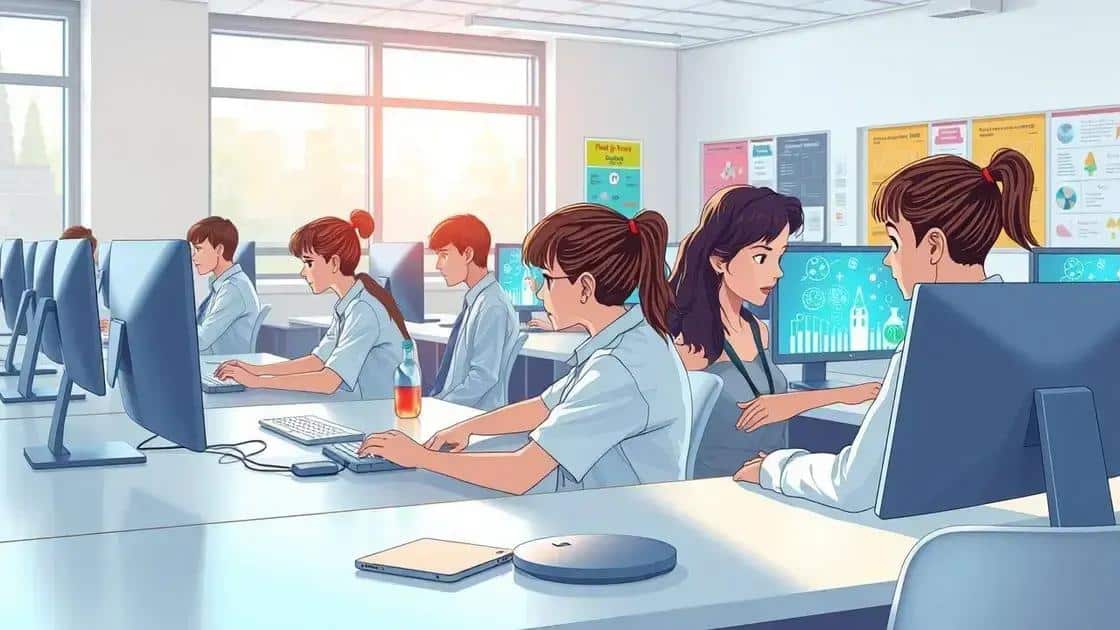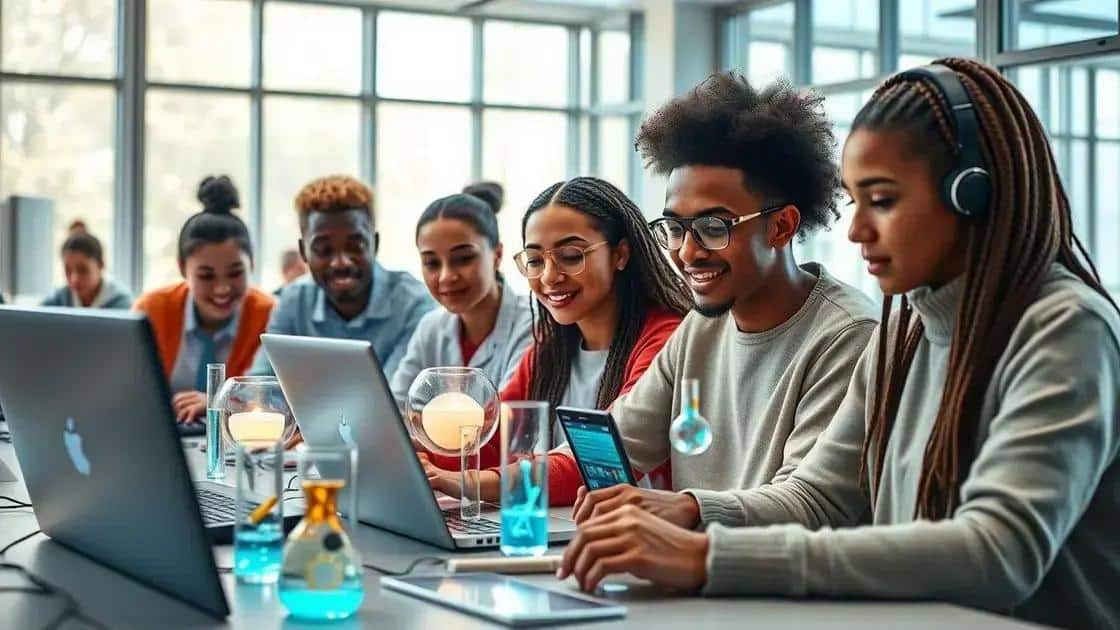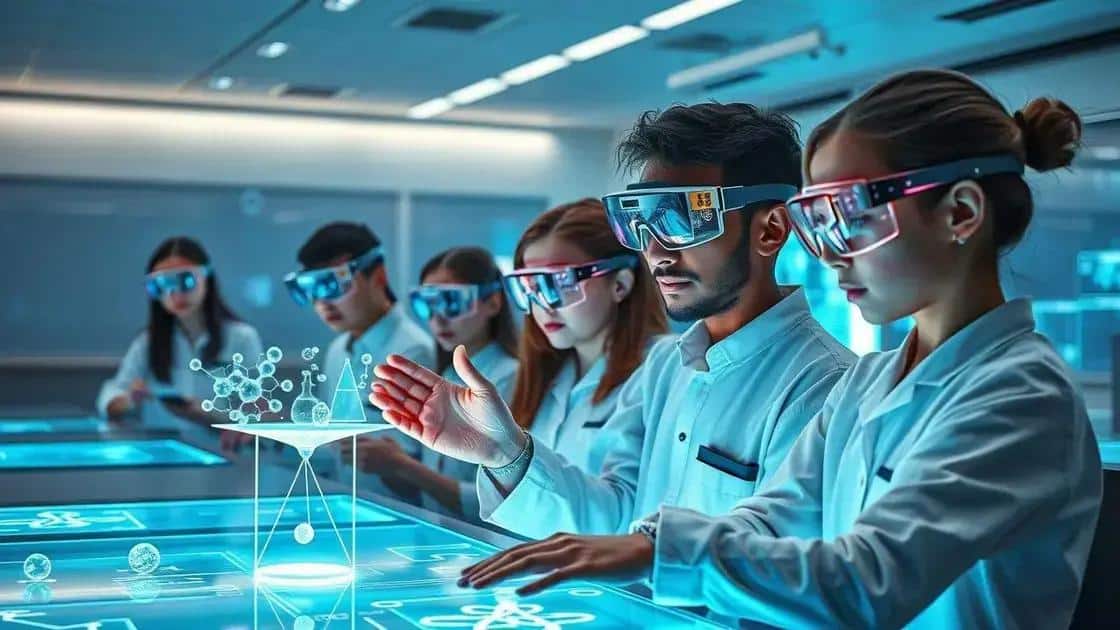Virtual lab simulations trends shaping the future

Virtual lab simulations enhance education by providing interactive, hands-on learning experiences, promoting accessibility and collaboration, while preparing students for real-world applications through advanced technology integration.
Virtual lab simulations trends are changing how we approach education and training. Imagine exploring complex scientific concepts right from your home! This article dives into these exciting trends and their implications.
Understanding virtual lab simulations
Virtual lab simulations represent a revolutionary way to engage with science and technology. By using virtual environments, learners can experiment freely without the constraints of a physical lab. This innovative method allows students to practice in realistic scenarios that enhance understanding and retention.
What are virtual lab simulations?
Virtual lab simulations are digital tools that mimic real-life laboratory experiences. They offer a safe and interactive platform for conducting experiments across various subjects. With these simulations, students can explore different scientific principles and processes in an engaging way.
Key benefits of virtual lab simulations
- Accessibility: Students can access labs from anywhere, removing geographical barriers.
- Cost-effective: Reduces the need for expensive materials and equipment.
- Safe experimentation: Allows for trial and error without consequences.
- Interactive learning: Engages students through hands-on experiences.
Moreover, these virtual environments often provide immediate feedback. This feature guides learners through their mistakes, fostering a deeper understanding of concepts. Imagine being able to mix chemicals or conduct physics experiments without any risks involved! The possibilities are endless with virtual lab technologies.
As education evolves, virtual lab simulations are becoming an essential tool in personalizing learning. They allow instructors to tailor experiences to individual student needs, ensuring that learners engage at their own pace. This personal touch can significantly enhance the learning experience.
Incorporating virtual lab simulations into academic programs can also help prepare students for real-world applications. By practicing in a virtual setting, they gain confidence and skills applicable in future careers. This preparation is crucial, especially in fields that rely heavily on technical abilities.
As we move forward, the integration of technology in education, such as virtual lab simulations, will continue to reshape how we learn. These trends highlight the importance of adapting educational practices to meet the demands of a rapidly changing world.
The impact of trends in virtual labs

The impact of trends in virtual labs is significant, shaping how education systems around the world approach science and technology. As these trends emerge, they transform traditional teaching methods, enabling more dynamic learning environments.
Changing the Educational Landscape
Virtual labs create opportunities for students to gain hands-on experience without the costs and risks associated with physical labs. This shift not only enhances engagement but also leads to better learning outcomes. One of the most exciting aspects is how these tools encourage collaboration. Students can work together on projects in real time, regardless of location.
Increased Accessibility and Flexibility
Another important impact of trends in virtual labs is the increased accessibility they provide. Students from remote or underserved areas can now participate in experiments that were once out of reach. This democratization of education allows all learners to benefit from high-quality resources.
- Remote learning: Virtual labs enable education beyond the classroom.
- Hands-on experiences: Students can practice skills in a safe environment.
- Global collaboration: Learners can connect with peers worldwide for joint projects.
As these tools develop, we see a focus on real-world applications. Virtual labs allow students to simulate situations they may face in their future careers, preparing them with relevant skills. This approach not only makes learning more engaging but also relevant to modern job markets.
Furthermore, the data collected during virtual lab activities helps educators assess student performance more effectively. Through analytics, teachers can identify areas where students struggle and tailor their instruction accordingly. This personalized approach makes learning more efficient and effective.
In summary, the trends influencing virtual labs are reshaping education. As we continue to embrace these advancements, the future of learning looks more interactive and inclusive than ever before.
Benefits of using virtual lab simulations
The benefits of using virtual lab simulations are immense, impacting both students and educators. By utilizing these innovative tools, learners gain access to experiences that enhance their education and skills.
Enhanced Learning Experiences
One major benefit is the ability to engage in hands-on learning without the typical constraints of a physical lab. Virtual labs allow students to conduct experiments in a safe environment. This freedom fosters creativity and encourages students to explore concepts without fear of failure.
Cost-Effective Education
Another substantial advantage is the cost-effectiveness of virtual lab simulations. Traditional lab setups often require expensive equipment and materials. By shifting to virtual simulations, schools can significantly reduce these expenses while still providing quality education.
- Accessibility: Students can learn from anywhere, breaking geographical barriers.
- Flexibility: Learners can work at their own pace, accommodating different learning styles.
- Environmental Impact: Reduces waste and resource consumption associated with physical labs.
Additionally, virtual lab simulations promote collaboration among students. They can connect and work on projects together, regardless of location. This interconnectedness mirrors modern work environments, preparing students for future careers.
Furthermore, the immediacy of feedback in virtual lab settings helps students identify areas for improvement. Instant evaluations allow them to grasp concepts thoroughly, which is vital for mastery. This interactive process keeps students engaged and motivated throughout their learning journey.
Overall, the benefits of using virtual lab simulations in education are clear. They create more inclusive, engaging, and effective learning environments that cater to the needs of all students, making education more accessible and impactful.
Future predictions for virtual lab simulations

Future predictions for virtual lab simulations show a landscape of exciting possibilities. As technology advances, these simulations are expected to evolve, becoming even more integrated into educational experiences.
Advancements in Technology
One major prediction is the enhancement of interactivity. Future virtual labs will likely include features such as augmented reality (AR) and virtual reality (VR), providing learners with immersive experiences. Imagine being able to conduct a chemistry experiment in a fully interactive environment, where every reaction comes to life around you!
Personalized Learning Experiences
Another key trend is the move toward personalized education. With advancements in artificial intelligence, virtual lab simulations will adapt to each learner’s pace and style. This means that students can receive customized feedback and instruction based on their unique needs.
- Increased collaboration: Future platforms may connect students globally, allowing real-time collaborations across distances.
- Data analysis: Enhanced analytics will provide educators with deeper insights into student performance, improving teaching methods.
- Wider subject coverage: Expanding to more disciplines, including arts and humanities, could broaden the use of virtual simulations beyond the sciences.
Additionally, as education continues to embrace online formats, these simulations are expected to become essential tools in remote learning environments. This integration will ensure students receive a comprehensive education, regardless of their circumstances.
Finally, sustainability will play a more significant role. As schools look to reduce their carbon footprint, virtual labs present an eco-friendly alternative to traditional lab resources and materials.
Overall, the future of virtual lab simulations holds great promise, positioning them as vital components of modern education.
FAQ – Frequently Asked Questions about Virtual Lab Simulations
What are virtual lab simulations?
Virtual lab simulations are digital tools that mimic real laboratory experiences, allowing students to conduct experiments in a safe and interactive environment.
How do virtual lab simulations enhance learning?
They provide hands-on experience, promote engagement, and allow students to explore concepts without the physical constraints of a traditional lab.
Can virtual lab simulations help students from remote areas?
Yes, they make science and technology education accessible to students regardless of their geographical location.
What future trends can we expect for virtual labs?
Future trends include the integration of augmented reality and personalized learning through AI, enhancing interactivity and customization for each student.





